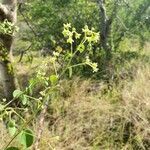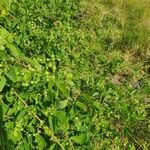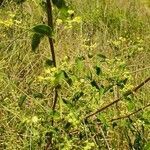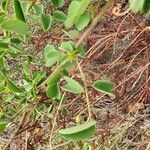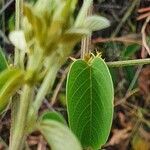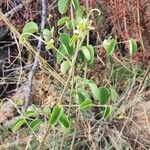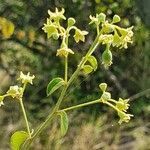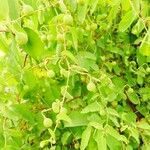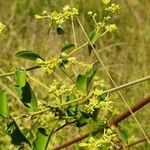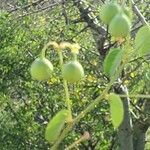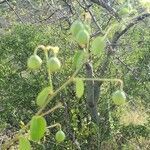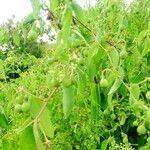Climbing shrub with tendrils, 0.2-6.0 m high. Leaves alternate, petioled, ± ovate-cordate; stipules linear, deciduous. Flowers in axillary, peduncled cymes. Calyx 5-lobed; tube campanulate; lobes slightly keeled on inner face. Petals 5, ± as long as calyx lobes, cucullate, inserted on margin of disc. Disc epigynous, flat, completely filling calyx tube. Stamens 5, equalling petals. Ovary inferior, 3-locular; style short, 3-fid. Flowering time Nov.-Mar. Fruit an obovate-globose capsule, areolate at apex, 3-coccous; cocci at length dehiscent, with a 3-partite, central axis. Seeds black, somewhat planoconvex, with keel on flat face.
Climbing or sprawling shrub, up to 6 m high; some branchlets reduced to unbranched, coiled tendrils. Leaves petiolate; blade ovate to broadly ovate or circular, 15-35 mm long, apex obtuse, mucronate, lateral veins prominent. Flowers: axillary, in few-flowered umbels; petals greenish yellow; Nov.-Mar. Fruit an obovoid, glabrous capsule.
Leaves petiolate; lamina 1·5–3·5 cm. long, ovate to broadly ovate or circular, apex rounded or mucronate, margin entire, base rounded to subcordate, penninerved, with 5–6 pairs of secondary nerves; lower surface puberulous, upper surface glabrous; petiole 5–7 mm. long, puberulous; stipules subulate, 2–5 mm. long.
A climbing shrub. It grows 6 m tall. It has coiled tendrils. The leaves are 2-4 cm long. They are broadly oval or round. There are hairs underneath. The flowers are in groups in the axils of leaves. The fruit is an oval capsule. The seeds are 3 angled. The seed coat is shiny black.
Climbing shrub up to 6 m high. Branchlets with coiled tendrils. Leaves petiolate, lamina ovate to broadly ovate or circular, 15-35 mm long. Capsule obovoid, glabrous. Flowers greenish yellow.
Ovary immersed in the disk; style 2 mm. long, with 3 spreading branches, or less than 1 mm. long and obscurely 3-lobed.
Climbing shrub to c. 6 m.; branchlets glabrous or glabrescent, provided with glabrous coiled tendrils.
Flowers in axillary pedunculate umbels; peduncle up to 2 cm. long; pedicels up to 6 mm. long, slender.
Petals 1·5–2 mm. long, obovate, cucullate, unguiculate.
Seeds 3-angled or plano-convex; testa shining black.
Sepals 2 mm. long, ovate-deltate, glabrous.
Disk 1–1·5 mm. in diam., annular.
Capsule obovoid, glabrous.
Stamens 1·5–2 mm. long.
